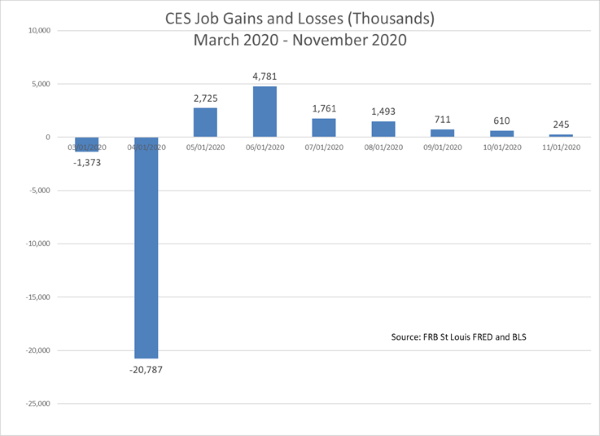Jobs - As Year End Approaches
The rate notwithstanding, there are still more than 10 million unemployed, and the economy is adding jobs at a decreasing rate.
Both the labor force participation rate and the size of the labor force have declined since the big drop in employment in April.
To make matters worse going into the new year, unemployment benefits will have run out for a significant number of the presently unemployed.
By Robert Eisenbeis
On Friday we got the last look at how the economy is performing, jobs-wise, before the end of the year. On the positive side, the economy did create 245,000 jobs in November, and the unemployment rate edged down to 6.7 percent. We note that critics argue the estimate is too low due to problems within the Bureau of Labor as to how the new claims for unemployment insurance are treated in the data. The rate notwithstanding, there are still more than 10 million unemployed, and the economy is adding jobs at a decreasing rate, as the attached chart shows. This trend is consistent with a slowing or stalled economy in many parts of the country, as noted in the Fed's November beige book.
We also now know that COVID-19 infections are surging; and with more and more states shutting down businesses temporarily and discouraging anything but necessary trips to stores, it is likely that by the time December is finished Q4 growth will have stalled completely. There are other signs, as well, in the jobs data that argue for slower than 2% GDP growth for Q4. Both the labor force participation rate and the size of the labor force have declined since the big drop in employment in April. The labor force is about 4 million workers smaller than it was in January 2020. Part of the reason for the drop is that furloughs have turned into permanent job losses as the pandemic and the resulting economic impacts have persisted. This situation, combined with the need for some working parents to stay home to help with the virtual schooling of their children, has resulted in more and more people becoming too discouraged to even look for employment.
To make matters worse going into the new year, unemployment benefits will have run out for a significant number of the presently unemployed. By one estimate, about 13.6 million people will have their pandemic-related unemployment benefits expire on December 26, 2020.
The 245,000 jobs number must be viewed in the context of pre-COVID employment data and is consistent with real GDP growth under 2.2-2.5%. Thus, growth is likely to be negative for the entire year; and it is clear, as the Federal Reserve has argued, that more fiscal support is needed to get us through the worst of the pandemic until a vaccine is fully available and widely administered.
Editor's Note: The summary bullets for this article were chosen by Seeking Alpha editors.

